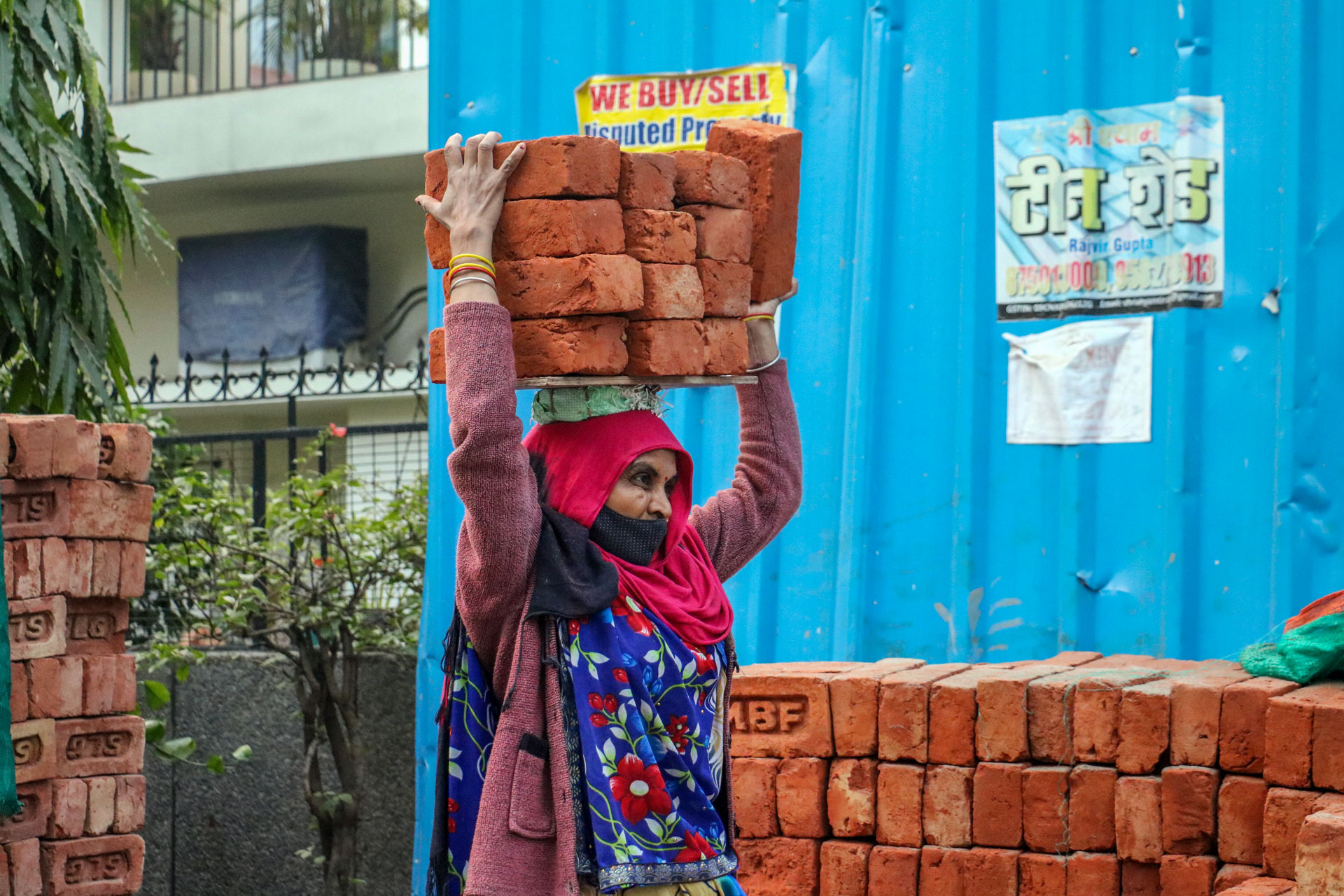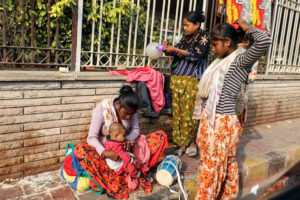India ranks 140 among 156 countries on WEF’s Global Gender Gap index

CMIE estimates that between mid-2016 and early 2020, the female labour participation rate fell from 16.4 pc to about 11 pc (MIG photos/Aman Kanojiya)
Iceland is the world’s best country for gender equality and Afghanistan the worst, a World Economic Forum index shows. Overall, this year’s report finds that progress has stagnated, with widening gender gaps in political empowerment globally. That means at the current rate, it will take almost 136 years for the overall global gender gap to close.
Not surprisingly, one of the worst performers in the index this year is India that has fallen 28 spots to rank 140th among 156 countries on the World Economic Forum’s Global Gender Gap index. In 2020, India had ranked 112th among 153 countries on the index. At 140, India is followed only by a handful of Arab nations or war torn countries like Mali, Yemen and Afghanistan. Dozens of countries like Burkina Faso or Malawi that are much poorer than India and rank lower on human development index, figure much higher than India in gender parity, showing exactly how far behind the world India is in achieving gender parity.
Price of pandemic
The report says that progress towards gender parity across the world has been severely impacted due to the Covid-19 pandemic, with women more likely to bear the brunt of the social and economic consequences. The report adds weight to a study published in The Lancet. The impact is so great it may even set us back, reversing some of the progress that has been made on equal rights, according to UN Secretary-General António Guterres.
This is backed up by the report, which says preliminary findings suggest that women have been more severely affected than men, and that in some cases, gender gaps that were closed, have reopened.
More women lost their jobs than men, while high-frequency LinkedIn data shows a decline of women’s hiring into leadership roles.
The World Economic Forum’s report said that another generation of women will have to wait for gender equality as 36 more years were added to the time left to close gender gap. “As the impact of the Covid-19 pandemic continues to be felt, closing the global gender gap has increased by a generation from 99.5 years to 135.6 years,” the report said. Added to that, the pandemic has destroyed roles in industries with strong gender representation and many women worked a “double-shift” of paid and unpaid work in a context of school closures, the report says.
The overall global gender gap covers scores across the four main components such as economic participation and opportunity, educational attainment, health and survival and lastly political empowerment. The results show that this year’s decline is mainly caused by a reversal in performance on the political empowerment gap.
The report said that India had so far closed 62.5 pc of its gender gap. It noted that most of the decline was seen on political empowerment, where India went back 13.5 percentage points. “The main change that took place this year is the significant decline in the share of women among ministers, which halved, from 23.1 pc in 2019 to 9.1 pc in 2021,” the report added. “In addition, the share of women in parliament remains stagnant at 14.4 pc and the share of the last 50 years in which a woman has been head of state is 15.5 pc.”
As most parties finalise candidate list for the upcoming assembly elections, poor representation of women in India’s political world continues. This despite the enormous number of speeches by all parties’ leaders about the important place women have in the legislative process. But when it comes to nominating women candidates, few leaders practice what they preach. No wonder then, that even 75 years after country became independent, women’s struggle for their basic rights such as electoral representation continues.
With the political parties not displaying any desire to significantly increase the representation of women in the electoral system, it is time to dust off the two-decade old women’s reservation bill and push it through the Parliament or rather Lok Sabha.
The Women’s Reservation Bill seeks to amend the Constitution to reserve one-third of all seats in the Lok Sabha and in all state legislatures for women. As per the proposed criteria, the Lok Sabha seats will be reserved on a rotational basis. One seat will be reserved once in every three general elections, the bill also mandates.
Low labour force participation
The report also adds another reason for India’s poor performance is the reduction in women’s labour force participation rate. Share of women in professional and technical roles declined further to 29.2 pc and share of women in senior and managerial positions also remains low as only 14.6 pc of these positions are held by women and there are only 8.9 pc of firms with female top managers, the report adds.
Indeed, women in India paid a disproportionately heavy and perhaps the highest price for pandemic. A recent study in Delhi found that in eight months, the unemployment rate in the national capital increased by 17 pc, with about 83 pc of women respondents choosing to permanently opt out of participating in the workforce. A similar trend has been observed throughout the country, and this at a time when the participation of women was already declining in the workforce with each passing year.
Mumbai-based economic research institution Centre for Monitoring Indian Economy (CMIE) estimates that between mid-2016 and early 2020, the female labour participation rate fell from 16.4 pc to about 11 pc. And now, it has been estimated that this number might have further been pushed this figure down to 9 pc due to the pandemic.
CMIE also said that while women accounted for only about 10.7 pc of the total workforce in 2019-20, they formed about 13.9 pc of the job losses India witnessed in April 2020. What’s worse is the fact that by the time November rolled about, while most men had recovered their jobs, women did not have the same fate.
Despite superior education than men, participation of women in India’s labour market, especially in urban areas, remains low, as per the Centre for Monitoring Indian Economy (CMIE). “Only 18.4 pc of urban women of 15 years or more of age were employed in 2018-19 according to PLFS. However, 68.6 pc of urban men in the same age bracket were employed,” says Vyas.
Another startling data published by the WEF’s Gender Parity Report is that the estimated earned income of women in India was one-fifth of men’s, which put India among the bottom 10 countries globally on that basis.

A UN report says 460,000 girls were missing at birth each year from 2013 to 2017 due to gender selection & female foeticide (MIG photos/Aman Kanojiya)
Health & survival
India’s women also seriously lag behind, not just the Indian males but also women in most nations around the world in terms of access to health and rate of survival, especially in the case of children below 5. Also, India fares extremely poorly in maternal deaths during child birth.
The WEF report cements the poor standing of India. “Discrimination against women is also reflected in health and survival sub-index statistics,” the report added. “With 93.7 pc of this gap closed to date, India ranks among the bottom five countries in this sub-index. Wide sex ratio at birth gaps are due to high incidence of gender-based sex-selective practices,” says the report.
A UN report says 460,000 girls were missing at birth each year from 2013 to 2017 due to gender selection & female foeticide. Overall, nearly 45.8 million females are ‘missing’ in Indian demography in the year 2020, mainly due to pre- and post-birth sex selection practices stemming from son preference and gender inequality, a report by the United Nations Population Fund (UNFPA) said.
Health and survival is the second-best subindex in terms of progress towards gender parity globally. WEF says that populous countries such as China, India, Azerbaijan and Pakistan have achieved scores that are lower than 94 pc, with China slightly progressing since the last edition. The main driver of cross-country variation is the skewed sex ratio at birth that can be attributed to the norms of son preference and gender-biased prenatal sex-selective practices. China and India together account for about 90–95 pc of the estimated 1.2 million to 1.5 million missing female births annually worldwide due to gender-biased prenatal sex selective practices. Further, China, India and Pakistan register excess female mortality rates (below age 5) related to neglect and gender-biased postnatal sex selection practices. The estimated number of ‘missing women’ was 142.6 million in 2020, twice as much than in 1970, when the number of missing women was estimated at 61 million.
Another UN report shows that as in 2012, India had the highest rate of excess female mortality at 13.5 per 1000 in the world. This excess was around 11.7 per cent of all deaths of females below five years of age indicating that one in nine such deaths was attributable to post-natal (after-birth) sex selection practices.
One of the primary areas of gender gap is reflected in malnutrition. As with several other aspects in terms of education or financial independence, the problem of malnutrition too has a strong bias against woman and girl child. For instance, child mortality in India is higher for females than that for males. While the under-five mortality rates for males is 38.4, for females it stands at 40.4. This shows that girls have a higher probability of dying before attaining the age of five years than boys.
Research shows that girls are neglected since the time of birth and are not given food properly as they are considered to be a burden in most Indian households. Boys on the other hand are fed properly. The gap between feeding a girl and a boy child becomes sharper in adolescence, experts say.
According to the World Health Organisation, 22.9 pc of women of 15-29 years are underweight as against 20.2 pc of men in same age group. Also, as many as 51.4 pc women of reproductive age suffer from anemia.
South Asia lags the entire world
As a whole, South Asia fared the worst amongst all sub-regions of the world, lagging way behind sub-Saharan Africa or Middle East or even the Pacific Ocean Island nations.
South Asia’s overall weight in terms of its population has a serious impact on gender parity in the world, the report infers. For instance, at the current relative pace, gender gaps can potentially be closed in 52.1 years in Western Europe, 61.5 years in North America, and 68.9 years in Latin America and the Caribbean. In all other regions it will take over 100 years to close the gender gap: 121.7 years in Sub-Saharan Africa, 134.7 years in Eastern Europe and Central Asia, 165.1 years in East Asia and the Pacific, 142.4 years in Middle East and North Africa, and 195.4 years in South Asia.
There is a sharp gap even within the South Asian region where a wide gulf separates the best-performing country, Bangladesh, which has closed 71.9 pc of its gender gap so far, from Afghanistan, which has only closed 44.4 pc of its gap. India is the third-worst performer in the region, after Afghanistan and Pakistan. Only Bhutan and Nepal made progress towards gender parity, says WEF.









